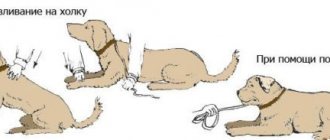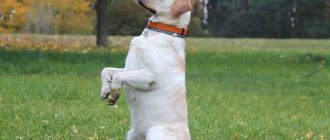The basis of dog education is that the dog sees a pack in the family; if a person does not prove himself to be a strong and confident leader, the dog will take on the specified mission, turning into a teacher and leader. This is where the roots of the pet’s disobedience and aggression come from. It is better to spend time eliminating the rebellion at its roots than to spend a lot of time later unsuccessfully correcting the situation.
Violence against dogs is prohibited.
First of all, you need to remember that raising a dog is not slapping a soft spot, which will not give anything other than causing pain to the pet. By the way, in a pack of dogs they don’t hit each other, so it’s pointless to mindlessly hit an animal. We need to come up with other, more humane ways to raise a ponytail.
Rewarding good behavior
Every correct action or reaction must be rewarded. And do not wait for this specific moment, but reward the dog immediately: within a few seconds after the praiseworthy behavior. If the dog has committed an offense and followed the wrong command, there is no need to punish the pet or use physical force. It will be enough if you do not give the animal a treat, toy or other reward.
Your commands for which your dog can be rewarded should be simple and clear. For example, “sit”, “lie down”, “fu”, etc. So that the animal understands why exactly it is being praised. And also, if several family members will train the dog, the reward system should be identical and consistent. For performing the same commands, you need to reward your friend equally. If the gift consists of some kind of delicacy or sweetness, the main thing is not to overfeed. Keep treats to a minimum.
Place
Training consists of several stages. Training should begin when your little friend knows the commands “lie down” and “come to me.”
Choose a place, lay a rug, a blanket there, or place a special lounger, then place a toy or bone nearby and start training.
Step one. Bring the dog to his place and say: “Lie down.” After this, move a short distance and call your pet to you. When the dog follows the command, give reinforcement and praise.
Step two. Repeat the exercise, but now point towards the sunbed with your hand and say: “Place.” The puppy can be slightly pushed in this direction by repeating the command. If the dog settles down, say “Place” again. If he doesn’t want to, give the command “lie down”, wait for it to be completed and repeat the command “place”. Thank you with a tasty treat, then walk back a few steps and call your pet to you.
Step three. Leave a treat on the bedding or, better yet, hide it in a toy to make it more interesting for your dog to look for it. Voice the command “place”. When the dog comes up to eat the treat, say: “Lie down,” praise him for following the command, and while he lies on the mat for at least 5 seconds, repeat the “place” command and treat him with the treat again.
After a few days of training, increase the distance from which the dog approaches its place to several meters.
– Basic commands, such as “sit”, “lie down”, “stand”, can be taught by yourself, but complex ones, for example, “barrier”, “die”, “fetch”, “jump on the back” - only with a dog handler. In these teams, you need to carefully monitor the execution technique, and in some exercises you even need to catch the dog, warns dog handler Zlata Obidova. – The general training course lasts two months, after which, if the dog has learned everything, a certificate is issued. But everything is individual. For some animals, even 15–20 sessions may not be enough.
When signing up for courses, pay attention to what breeds of dogs are recruited into the group. Animals must be similar in size. Dwarf breeds cannot be trained together with fighting breeds.
"Bite" to explain something
Until you became its owner, the dog was commanded by the mother. To deal with a disobedient child, the animal world has its own way: the mother bites the puppy in the neck or simply rolls it onto its back.
A person can also use these same methods, but to imitate a bite, you need to tense your fingers and simply hit the neck with the tips, but only from above, where the skin is rougher.
If the behavior has not changed, then throw the naughty person on his back. It is possible that the pet will not understand the first time, but by the third time he will definitely realize that he is to blame.
Raising a puppy. Where to start and how to succeed
As soon as a puppy appears in your home, he immediately becomes an object of attention and admiration for the whole family. He is pampered, touched by small pranks, chewed slippers and broken flowers are forgiven. Meanwhile, the dog lays the foundations for incorrect behavior and forms bad habits that will not be so easy to eradicate. A wise owner knows how important it is to start training a dog in a timely manner. This is a continuous process, often difficult, but very interesting.
Where to start raising a puppy? How to do this correctly?
From the very first hours of being in the house, the dog should feel the friendly attitude of the people around it. Often a small puppy, cut off from its canine family, feels defenseless and lonely in a new environment. The dog is a pack animal that understands and respects pack discipline. Therefore, the dog owner needs to try to become the leader of this conditional pack.
From the very first days, explain to the puppy what is allowed to do and what is not. Your requirements must be understandable to the animal—specific and consistent. Associate the puppy's correct actions with pleasant sensations for him.
And, conversely, the pet’s unwanted actions should be associated with unpleasant experiences. Bad behavior cannot be ignored. At the same time, remember that no matter how smart your four-legged friend is, he is still just a dog, so you should not demand from him too subtle an understanding of human emotions, to be offended, jealous, or shame. Do not make your puppy suffer from unfounded and incomprehensible reproaches.
At what age should you start training a puppy?
The earlier the better. The main thing is not to overload it too much, since at an early age it is difficult for a dog to concentrate and quickly gets bored of studying. Do small training sessions of five minutes each and try to keep them fun and play-like for your puppy.
First of all, teach your pet to respond to its name. Call your puppy for feeding or while walking. You can gradually learn the command “come to me” . At the same time, try to keep the tone of your voice calm and friendly.
Starting from the age of two months, teach the puppy the command “no” (or “fu” ). It should be said in a low, sharp voice, but under no circumstances should you shout, otherwise you may frighten and disorient the animal.
If you live in a city, then you need to teach your dog to walk on a leash as early as possible. First, try wearing a collar occasionally and, as soon as you understand that your pet is calm about it, fasten the leash. In a calm, gentle voice, force the puppy to follow you and, if he follows, reward him with something tasty.
At the very beginning, stop the habit of pulling on the leash. Pull the leash sharply and strictly command: “Near!” . When your dog releases the tension, be sure to reward him. Remember to be safe when walking: do not let your dog off leash near traffic and stay away from large, aggressive dogs.
Do not allow your puppy to happily greet strangers, chase bicycles or bark for any reason, otherwise it may turn into a bad habit. It is also worth teaching your pet to behave calmly when meeting friends or during visits to a guest’s house.
Some of the simplest commands to teach your dog are the "sit" and "down" . The easiest way is to teach your puppy to sit while waiting for a tasty morsel in your hands. Don't try to make your dog sit for as long as possible.
It is better to let her sit for a few seconds and get up with your permission than for one minute, but get up when she wants.
To practice the “lie down” command, first sit the dog down, then, having said the command, stretch out its front legs with one hand and press on the withers with the other. When your dog learns to lie down correctly, take a step away from him. When you try to get up, strictly command: “Lie down!”
Remember to reward your dog when he does what is required. The animal is sensitive to mood and tone of voice, so try to give commands in a firm, stern, but calm voice. Under no circumstances should you shout or even hit the dog. Otherwise, you may turn from an authority figure into an enemy and lose your pet’s trust.
You might like our article on how to properly train a puppy to stop biting.
Typical mistakes when training:
- Complicating the technique before the previous stage has been completed;
- Carrying out too long training sessions, especially in the early stages of training;
- Inconsistency of requirements and lack of control over implementation;
- Nervous or aggressive behavior when training a dog.
Don't forget to develop your four-legged friend's natural instincts. Imitation of hunting will allow you to realize unspent energy (this is especially true for dogs of hunting breeds), strengthen mutual understanding between the dog and its owner, and bring great joy to both.
Teach your dog to retrieve a stick or ball thrown into the distance. Before making a throw, say the command “fetch” . In summer, these activities can be combined with swimming in a pond, unless there are many people present there. Increase the time spent waiting for a command, thereby strengthening control over the dog.
Monitor your pet's behavior and do not ignore dangerous tendencies and aggressive behavior. The character of a dog, like the character of a person, can be trained. Communicate with her more, walk, play, teach her new things, and then your dog will become your pride and faithful friend for many years.
Features of training dogs of different breeds
Each breed of dog has its own characteristics of behavior and character. This is important to consider when creating a training program for a specific animal.
Training small breed puppies
Small breed dogs belong to the decorative group. They are light in weight, up to 10 kg, and miniature in size. It is convenient to keep such animals in city apartments; they do not create much trouble, eat little and do not pose a particular danger to others. But this does not at all exclude the need to raise a dog so that further communication and living with it brings only joy and pleasure to the owner.
What a small breed dog should know and be able to do:
1. Know your place in the house.
2. Execute the command “Place”, “Come to me” and “Lie down”. 3. Be accustomed to a collar and leash. 4. Obey the owner and stop your actions when you hear the command “Fu!” or "You can't." 5. Go to the toilet using a special tray or while walking outside. 6. Do not show aggression when the owner performs the necessary medical and hygienic manipulations on her. 7. The dog should not beg the owner for treats from the table. She needs to be accustomed to a diet of 2-4 times a day, depending on her age. 8. During walks, the dog should not run far from the owner or chase other animals or people. In order for a small dog to perform all the necessary actions, it must be trained from an early age, obedience and good behavior must be instilled in it.
Training of medium and large breed puppies
For dogs of medium and large breeds, an individual training program is drawn up, taking into account their characteristics and character.
For example, shepherds and other working breed dogs are considered the smartest animals, and their intellectual abilities are evident from the first months of life. If the owner starts training on time, such a dog will become the most devoted and obedient, ready to unquestioningly carry out all the owner’s commands.
Fighting breed dogs require special education and training. They are aggressive and can be dangerous to others. In training, you need to show willpower and an iron character, which will help raise an obedient and socially harmless dog.
Is it possible to train an adult dog?
Many people believe that it is impossible to teach commands to an adult dog, but this opinion is wrong. With the right approach to training, you can educate and discipline even an elderly animal. The only caveat: training dogs with already established behavior and character is a longer process that requires persistence, patience and self-control from the owner. Showing aggression is unacceptable; only friendly contact will encourage the animal to carry out the owner’s instructions.
Mistakes when training dogs
Inexperienced dog breeders often make mistakes when training pets, which makes the learning process difficult or does not produce results at all. Let's look at the most common ones.
Mistakes during training:
1. The desire to “humanize” the dog, placing increased demands on it that are impossible for an animal to meet. A person must subjectively evaluate the dog’s capabilities, characteristics of its behavior and intelligence. You cannot demand or try to instill in animals skills typical of humans. 2. Lack of an individual approach in the training process. Each dog is individual, therefore, when developing a training strategy, the owner must take into account the dog’s breed, its character, age and other personal criteria. 3. The desire to practice as many skills as possible in one training process. Lack of consistency in the development of various techniques, careless practice of acquired skills. Such training does not give good results. Any new skill needs to be practiced, bringing it to automaticity. It is imperative to follow a strict sequence - from simple techniques to more complex ones. 4. Overtraining associated with excessively frequent training and a very long learning process at a time, which leads to overwork of the animal’s nervous system. The owner needs to control the training time and not force her to perform the same action more than 2-3 times. Also, you should not train several times a day. The dog must be given time to rest. 5. Abuse of treats given for reward purposes. Dog trainers do not recommend giving a treat to your dog after each technique. She will quickly get full and stop obeying her owner. You can thank your dog for his obedience with a kind word or a stroke.
Training methods and nuances
Even before training begins, you need to carefully study your pet's behavior. Particular attention should be paid to the circumstances under which the dog begins to bark. The easiest way to find out is while walking while playing a game. It is necessary to note the dog’s reaction to any external factors. A dog can vocalize for many reasons: he sees his favorite toy, wants to eat, or simply barks because of the excitement that was caused by the game process.
To stimulate the dog to vocalize, you need to choose a suitable stimulus and make sure that he hears the word “Voice” during his barking. Gradually, the pet will develop a certain reflex - it will bark only when the owner gives the appropriate command.
Casting a vote on the ball
In order for a dog to bark on command, it must be accustomed to the fact that the owner giving the order behaves in a special way. If the puppy barks at the sight of a toy (for example, a ball), you can show him the ball and, when he starts barking, raise your palm and loudly and distinctly say “Voice!”
Encouragement is an important point in any training. Dogs can be stimulated in different ways: some will learn commands better if rewarded with affection, others need to be given some kind of treat. Training should be regular. You need to exercise your dog for at least 5 minutes a day. If the dog has performed the action required of him, he must be praised, stroked, or given a treat.
When the dog starts barking every time the ball appears, you need to move on to the next step - remove the ball and give the command by raising your hand. Soon the dog will begin to bark strictly on command.
Voicing for a treat
You can teach your dog this command using his favorite food. To do this, sit your pet nearby, holding the leash with your hand, let him sniff the treat, then immediately move your hand higher so that the dog cannot reach it (this is why a leash is required).
When the dog starts barking, you need to immediately say “Voice”, then give him a treat and pet him. Such exercises should only be done when the dog is hungry. After a week of training, the treat can be replaced with simple praise.
Voting for a company
Sometimes finding the right stimulus for learning can be extremely difficult. In this case, you can try to train the dog by showing it an example. To do this, you need to find a dog that already knows how to perform the “Voice” command, sit it next to yours and command both of them. A dog that barks on command should be rewarded immediately. The second dog will quickly understand what he needs to do.
It is important to train your pet not only to speak on command, but also to stop barking in a timely manner. The “Quiet” team will help you cope with this task. While the learning process is taking place, it is necessary to stop any attempts by the dog to bark for no particular reason.
Exercises to consolidate knowledge
Exercises to consolidate results are also of great importance for the effectiveness of memorization and the development of discipline. In everyday life, you can periodically ask your dog to give him a paw.
For example, you can ask your pet to give a paw in the morning after waking up. During the game, you can also repeat the training by being friendly. There may be several such moments during the day. This is the only way to quickly and effectively train a student.
Additional Information. There is no need to demand that actions be repeated every half hour, as this can irritate the ward.
You can teach your pet to give a paw on your own, or by sending it to a group where professional training will be provided. In this case, you need to choose a suitable training method and take into account the abilities of the ward. The main thing to remember is that your pet needs to be loved and encouraged in every possible way. You cannot show aggression and punish the dog for misdeeds. Then the dog will definitely be able to learn anything.
Team Dai
An important command that will make your life with your dog much easier. Imagine that on the command “Give” the dog will let go of the object that he grabbed with his teeth. For example, your favorite shoes or mobile phone that you were going to chew on a little.
How to teach the "Give" command
This will be fun because the "Give" command needs to be taught as you play. Take a toy and excite the dog so that he grabs it with his teeth. Do not let go of the object and take it from the dog, accompanying this action with the word “Give.” Reward your pet with a treat for opening his teeth and allowing you to take the item. Repeat as many times as possible until the dog begins to give you the toy upon request.
Buy a puppy? First prepare the house
When you get a dog, it is vital to make your home and garden safe before he arrives home. Puppies explore the world around them, tasting it, they need to chew, so anything left on the floor, be it shoes, clothes or books, is most likely to be bitten. Therefore, it is very wise to put anything that your puppy might chew on out of his reach.
Particularly attractive are children's toys , which are usually not designed to be persistently nibbled and chewed. If left unattended, they will be hopelessly damaged and can also harm the pet: a dog may swallow or inhale a small part while playing, and in some cases surgical intervention may be required. Therefore, keep puppies out of the nursery and make sure that toys are not scattered around the house.
Make sure that your garden fence does not allow your puppy to escape and that there are no dangerous plants in your garden (lists of dangerous species are easy to find on the Internet). It also makes sense to limit your puppy's access to certain parts of the house at first. Child safety gates can help with this. Everything you might need to care for your puppy, feed your puppy, and train your dog is on this list.
Common Mistakes
Not all dogs can be trained to follow the “Voice” command. Some breeds are simply not trainable, such as most hunting dogs. In addition, excessive pressure on the dog can negatively affect his psyche - cause aggression or even illness. If you are unable to train your dog on your own, it is recommended that you contact a professional.
During the training process, it is strictly contraindicated to punish or beat the dog. This can only spoil her character and make her very aggressive. All commands must be pronounced in a calm, even and clear voice, and no anger or dissatisfaction should be heard in the sound of the voice.
Whatever training option is used, we must not forget that a dog is a living, intelligent creature. The dog will happily follow any command if the owner treats him well and with respect.
Useful tips and recommendations from experts
For inexperienced dog breeders planning to start training a pet, we recommend learning useful tips and tricks from experienced dog handlers.
Dog Training Tips:
1. Commands must be pronounced loudly, briefly, with confident intonation.
2. You can’t be too strict when dealing with an animal. Have patience and control your emotions. You cannot beat or cruelly punish a dog for disobedience. 3. Each technique should be repeated at each lesson, practicing the acquired skill. 4. The training system is built from simple to complex. The load and time of training gradually increases. 5. For obedience and following new commands, the dog should be rewarded with a tasty treat, but in moderation. 6. Maintain consistency and stick to the same tactics. If you introduce any prohibitions, always follow them, otherwise the dog will stop obeying you. Basic rules in compliance with the educational process techniques will allow you to train a domestic dog of any breed and age. Be patient and be prepared to spend a lot of time and effort on the training process, but these efforts will not be in vain!
Why teach
The “Voice” command is part of the mandatory commands for the dog. It is included in the basic standard of any service dog. With the help of barking, he can scare away an uninvited guest, give a signal, protect the house, or show his attitude towards a stranger.
But if you approach training incorrectly, your dog can develop the habit of barking for no particular reason. He will vote solely for the sake of encouragement. In this case, it will be problematic to wean the dog from this method of communication, so training should be carried out taking into account strict rules. It is best to use techniques that have been proven by time and the experience of thousands of dog breeders.
Command Cannot
The “No” command is one of the most important in communication between a person and a dog. If the pet does not know such a command, it will be very difficult to control it. In addition, such a command can save the animal’s life. For example, it will be possible to stop a dog during a walk when it tries to take a poisoned bait.
Do not abuse these commands under any circumstances. They should only be said when truly necessary. This will give the "Don't" command a high value.
How to teach the “No” command
Take a treat in your palm and bring it to your dog’s nose. When the animal tries to take it, squeeze your palm and say “No.” Repeat this exercise several times. When the dog stops trying to take the treat, nuzzles the hand, and looks the owner in the eyes - only at this moment give him the treat. Accompany this action with the word “Take.”
The next step is to place the treat on the floor and repeat the exercise.
Labrador training
The Labrador is a companion dog and is suitable for families with children. In order for you to have a wonderful friend, you need to have basic knowledge of how to train a Labrador. The puppy can be taught all the necessary commands at home.
Dogs of this breed completely trust a person, they do not expect nasty things from the trainer, so they can train for a long time and with great pleasure. They love human interaction, so they will happily accept a stroke or a kind word as praise instead of a treat.
The Labrador is a peace-loving dog; it will be less distracted during training with other animals, unlike fighting breeds. These dogs have a temperament - they cannot be called lethargic, but they are not impulsive, moderately active, with healthy motor activity - just what is necessary for successful training.
General recommendations for beginners
If your dog knows various commands, you will be comfortable going for walks with him. Many of you don’t know how to teach a dog commands, so we wanted to tell you more about it.
The owner can train the pet himself. There are situations when the owner plans to attend various competitions or exhibitions; in such a situation, it is better if a specially trained person is involved in the training.
It all depends on the purpose for which you need to teach the dog various commands. It will take you a long time to learn, so you need to be patient.
From the first days of training, the owner should praise his pet if he performs the tasks correctly. There are situations when the dog refuses to do something, so you need to be strict with your pet during training.











